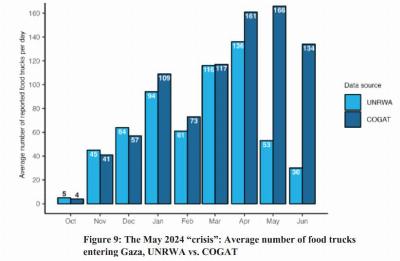"Narratives of Israeli genocide, war crimes, and deliberate mass starvation in the ongoing war in Gaza have been challenged, and in some cases debunked, in a new comprehensive study published on Wednesday titled ‘Debunking the Genocide Allegations: A Reexamination of the Israel-Hamas War (2023-2025).’
The study, published by the Begin-Sadat Center for Strategic Studies and the Hebrew University of Jerusalem, critically challenges the narrative of Israeli genocide during the conflict by analyzing humanitarian reporting and casualty data.
The study, spanning 311 pages, also employed quantitative analysis and forensic documentation to analyze and challenge widely reported claims from international organizations and courts. The authors, led by Professor Danny Orbach, stated that their objective was to provide a factual analysis rather than a legal or moral exoneration.
The publication of the study comes at a crucial time, as the IDF is poised to begin an invasion of Gaza City as part of the newest operation - ‘Gideon's Chariots II.’ ...
The study is structured into eight chapters, each addressing specific allegations and themes related to the conflict and its reporting. The overarching themes that emerged from the research were a critique of humanitarian reporting, a re-evaluation of casualty data, and a call for a new methodological framework for analyzing conflicts.
Challenging the Starvation Narrative
Perhaps the study's most controversial finding concerns food supply to Gaza. The researchers argued that more food entered Gaza during the war than before October 7, 2023, a claim that starkly contradicts widespread reports of imminent famine and deliberate starvation.
According to the study, the frequently cited requirement of 500 aid trucks daily entering Gaza stems from what the authors call ‘a misrepresentation by UN bodies.’ They point to pre-war UN records showing an average of only 73 food trucks per day in 2022.
The 500 figure has been regularly cited throughout the war by the UN, as well as international media outlets such as CNN, The Guardian, and The Washington Post.
During the fighting until January 17, 2025, COGAT (the Israeli military body coordinating activities in the territories) recorded an average of 101 food trucks daily, while retroactively corrected but incomplete UNRWA data indicated 83 food trucks per day. Another example is their claim that food which entered Gaza during the ceasefire ‘should have sufficed until late July 2025 according to WFP projections.’ They attribute the gap between projected sufficiency and reported shortages to ‘extensive looting by Hamas.’
The study also disputed claims about Gaza's agricultural self-sufficiency. Contrary to claims that 44% of Gaza's food comes from local agriculture, the researchers assert this figure was ‘baseless.’ They calculated that Gazan agriculture likely accounted for no more than 12% of caloric consumption in 2005 and that even if all of Gaza's 2011 crops were replaced, the number of trucks entering Gaza per capita throughout the war would still be 58% higher than in 2011...
Questioning Casualty Reporting
The study then took direct aim at casualty figures reported by the Hamas-run Gaza Health Ministry, alleging systematic data manipulation. According to the researchers, the Health Ministry, ‘per Hamas directives, categorizes all deaths as civilian,’ which they argue has ‘significantly skewed international reporting.’ The report found indications that the Ministry's lists include ‘age-related natural deaths, particularly of women,’ while excluding ‘combat-aged men.’
This selective reporting, they argued, artificially inflates civilian casualty figures and obscures the actual combatant-to-civilian death ratio. The study's analysis of GMOH reports revealed a fluctuating and often implausible distribution of casualties.
As of March 2025, the GMOH had reported 50,021 combat-related casualties. The study also noted that the number of reported widows, at 13,900, almost matched the official excess male mortality figure of 13,964 for ages 18-59, which they found to be ‘striking.’
The researchers also presented data suggesting that evacuation zones designated by the IDF were ‘significantly safer’ than other areas. According to their partial data analysis, less than 4% of deaths occurred in Mawasi and the central camps, areas marked as evacuation zones. They attribute higher casualties elsewhere to ‘the failure of the UN to cooperate with the establishment of such zones.’
Systematic Critique of International Reporting
A substantial portion of the study focused on what the authors described as ‘systematic failures in UN and NGO reporting.’ They identify patterns of ‘circular citation, opaque assessments, and unannounced retroactive corrections’ that they argue have distorted the international understanding of the conflict. One example they highlight involves UNRWA's truck count discrepancies.
While UNRWA initially reported a 70% drop in aid after May 2024 and the Rafah operation, the agency ‘later retroactively corrected these reports.’ Crucially, the authors noted, ‘this correction was effectively unannounced and hence the supposed aid drop continues to be cited broadly.’..."
September 3, 2025
New study debunks Gaza genocide claims, finds flaws in U.N., int'l reporting on war

A graph depicting the descrepancy between UNRWA and COGAT reporting on aid trucks entering the Gaza Strip. (credit: Canva, Courtesy Bar-Ilan University)
Date
September 3, 2025
Title
New study debunks Gaza genocide claims, finds flaws in U.N., int’l reporting on war, The Jerusalem Post
Author(s)
Jacob Laznik
Original Source
